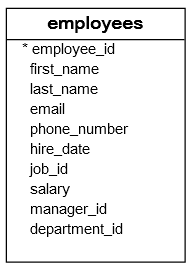摘要:本教學將示範如何使用 SQL 的 ORDER BY 子句,根據指定的條件,以遞增或遞減的順序排序結果集。
SQL ORDER BY 子句簡介
ORDER BY 是 SELECT 語句的可選子句。 ORDER BY 子句允許您根據一個或多個排序運算式,以遞增或遞減的順序排序 SELECT 子句返回的行。
以下顯示 ORDER BY 子句的語法
SELECT
select_list
FROM
table_name
ORDER BY
sort_expression [ASC | DESC];Code language: SQL (Structured Query Language) (sql)在這個語法中
- 首先,將
ORDER BY子句放在FROM子句之後。資料庫將按照以下順序評估帶有ORDER BY* 子句的SELECT語句:FROM>SELECT>ORDER BY。 - 其次,在
ORDER BY子句之後指定排序運算式。排序運算式指定排序條件。 - 第三,使用
ASC選項按遞增順序依排序運算式排序結果集,並使用DESC按遞減順序依排序運算式排序結果集。
請注意,如果您沒有使用 ASC 或 DESC,ORDER BY 子句預設會使用 ASC 選項。
ORDER BY 子句也允許您依多個運算式排序結果集。在這種情況下,您需要使用逗號分隔兩個排序運算式
SELECT
select_list
FROM
table_name
ORDER BY
sort_expression_1 [ASC | DESC],
sort_expression_2 [ASC | DESC];Code language: CSS (css)在這個語法中,ORDER BY 子句首先依 sort_expression_1 排序結果集,然後依 sort_expression_2 排序已排序的結果集。
請注意,如果您未指定 ORDER BY 子句,SELECT 語句將不會排序結果集。這表示結果集中的行沒有特定的順序。
SQL ORDER BY 子句範例
我們將使用範例資料庫中的 employees 表格進行示範。

1) 使用 SQL ORDER BY 子句排序單一欄位的值範例
以下 SELECT 語句返回 employees 表格中 employee id、first name、last name、hire date 和 salary 欄位的資料
SELECT
employee_id,
first_name,
last_name,
hire_date,
salary
FROM
employees;Code language: SQL (Structured Query Language) (sql)+-------------+-------------+-------------+------------+----------+
| employee_id | first_name | last_name | hire_date | salary |
+-------------+-------------+-------------+------------+----------+
| 100 | Steven | King | 1987-06-17 | 24000.00 |
| 101 | Neena | Kochhar | 1989-09-21 | 17000.00 |
| 102 | Lex | De Haan | 1993-01-13 | 17000.00 |
| 103 | Alexander | Hunold | 1990-01-03 | 9000.00 |
| 104 | Bruce | Ernst | 1991-05-21 | 6000.00 |
| 105 | David | Austin | 1997-06-25 | 4800.00 |
| 106 | Valli | Pataballa | 1998-02-05 | 4800.00 |
| 107 | Diana | Lorentz | 1999-02-07 | 4200.00 |
| 108 | Nancy | Greenberg | 1994-08-17 | 12000.00 |
| 109 | Daniel | Faviet | 1994-08-16 | 9000.00 |
| 110 | John | Chen | 1997-09-28 | 8200.00 |
...您可以從輸出清楚地看到,這些行沒有任何順序。
以下範例使用 ORDER BY 子句,按名字的字母順序排序員工
SELECT
employee_id,
first_name,
last_name,
hire_date,
salary
FROM
employees
ORDER BY
first_name;Code language: SQL (Structured Query Language) (sql)+-------------+-------------+-------------+------------+----------+
| employee_id | first_name | last_name | hire_date | salary |
+-------------+-------------+-------------+------------+----------+
| 121 | Adam | Fripp | 1997-04-10 | 8200.00 |
| 115 | Alexander | Khoo | 1995-05-18 | 3100.00 |
| 103 | Alexander | Hunold | 1990-01-03 | 9000.00 |
| 193 | Britney | Everett | 1997-03-03 | 3900.00 |
| 104 | Bruce | Ernst | 1991-05-21 | 6000.00 |
| 179 | Charles | Johnson | 2000-01-04 | 6200.00 |
| 109 | Daniel | Faviet | 1994-08-16 | 9000.00 |
| 105 | David | Austin | 1997-06-25 | 4800.00 |
| 114 | Den | Raphaely | 1994-12-07 | 11000.00 |
| 107 | Diana | Lorentz | 1999-02-07 | 4200.00 |
...ORDER BY 依 first_name 欄位中的值排序這些行。
2) 使用 SQL ORDER BY 子句排序多個欄位的值範例
以下範例使用 ORDER BY 子句,先按名字的遞增順序排序員工,然後按姓氏的遞減順序排序
SELECT
employee_id,
first_name,
last_name,
hire_date,
salary
FROM
employees
ORDER BY
first_name,
last_name DESC;Code language: SQL (Structured Query Language) (sql)+-------------+-------------+-------------+------------+----------+
| employee_id | first_name | last_name | hire_date | salary |
+-------------+-------------+-------------+------------+----------+
| 121 | Adam | Fripp | 1997-04-10 | 8200.00 |
| 115 | Alexander | Khoo | 1995-05-18 | 3100.00 |
| 103 | Alexander | Hunold | 1990-01-03 | 9000.00 |
| 193 | Britney | Everett | 1997-03-03 | 3900.00 |
| 104 | Bruce | Ernst | 1991-05-21 | 6000.00 |
| 179 | Charles | Johnson | 2000-01-04 | 6200.00 |
| 109 | Daniel | Faviet | 1994-08-16 | 9000.00 |
| 105 | David | Austin | 1997-06-25 | 4800.00 |
| 114 | Den | Raphaely | 1994-12-07 | 11000.00 |
| 107 | Diana | Lorentz | 1999-02-07 | 4200.00 |
| 118 | Guy | Himuro | 1998-11-15 | 2600.00 |
...在這個範例中,ORDER BY 子句先依名字的遞增順序排序結果集,然後依姓氏的遞減順序排序已排序的結果集。
請注意結果集中兩名員工的位置變化:Alexander Khoo 和 Alexander Hunold。
3) 使用 SQL ORDER BY 子句排序數值欄位的值範例
以下範例使用 ORDER BY 子句,依薪資從高到低排序員工
SELECT
employee_id,
first_name,
last_name,
hire_date,
salary
FROM
employees
ORDER BY
salary DESC;Code language: SQL (Structured Query Language) (sql)+-------------+-------------+-------------+------------+----------+
| employee_id | first_name | last_name | hire_date | salary |
+-------------+-------------+-------------+------------+----------+
| 100 | Steven | King | 1987-06-17 | 24000.00 |
| 101 | Neena | Kochhar | 1989-09-21 | 17000.00 |
| 102 | Lex | De Haan | 1993-01-13 | 17000.00 |
| 145 | John | Russell | 1996-10-01 | 14000.00 |
| 146 | Karen | Partners | 1997-01-05 | 13500.00 |
| 201 | Michael | Hartstein | 1996-02-17 | 13000.00 |
| 205 | Shelley | Higgins | 1994-06-07 | 12000.00 |
| 108 | Nancy | Greenberg | 1994-08-17 | 12000.00 |
| 114 | Den | Raphaely | 1994-12-07 | 11000.00 |
...4) 使用 SQL ORDER BY 依日期排序範例
除了字元和數值資料外,您還可以使用 ORDER BY 子句依日期排序行。例如,以下語句使用 ORDER BY 子句,依 hire_date 欄位中的值排序員工
SELECT
employee_id,
first_name,
last_name,
hire_date,
salary
FROM
employees
ORDER BY
hire_date;Code language: SQL (Structured Query Language) (sql)+-------------+-------------+-------------+------------+----------+
| employee_id | first_name | last_name | hire_date | salary |
+-------------+-------------+-------------+------------+----------+
| 100 | Steven | King | 1987-06-17 | 24000.00 |
| 200 | Jennifer | Whalen | 1987-09-17 | 4400.00 |
| 101 | Neena | Kochhar | 1989-09-21 | 17000.00 |
| 103 | Alexander | Hunold | 1990-01-03 | 9000.00 |
| 104 | Bruce | Ernst | 1991-05-21 | 6000.00 |
| 102 | Lex | De Haan | 1993-01-13 | 17000.00 |
| 203 | Susan | Mavris | 1994-06-07 | 6500.00 |
| 204 | Hermann | Baer | 1994-06-07 | 10000.00 |
...要查看從最近到最早加入公司的員工,您可以依聘用日期的遞減順序排序員工
SELECT
employee_id,
first_name,
last_name,
hire_date,
salary
FROM
employees
ORDER BY
hire_date DESC;Code language: SQL (Structured Query Language) (sql)+-------------+-------------+-------------+------------+----------+
| employee_id | first_name | last_name | hire_date | salary |
+-------------+-------------+-------------+------------+----------+
| 179 | Charles | Johnson | 2000-01-04 | 6200.00 |
| 113 | Luis | Popp | 1999-12-07 | 6900.00 |
| 119 | Karen | Colmenares | 1999-08-10 | 2500.00 |
| 178 | Kimberely | Grant | 1999-05-24 | 7000.00 |
| 107 | Diana | Lorentz | 1999-02-07 | 4200.00 |
| 118 | Guy | Himuro | 1998-11-15 | 2600.00 |
| 126 | Irene | Mikkilineni | 1998-09-28 | 2700.00 |
| 177 | Jack | Livingston | 1998-04-23 | 8400.00 |
| 176 | Jonathon | Taylor | 1998-03-24 | 8600.00 |
...摘要
- 使用
ORDER BY子句排序SELECT子句返回的行。 - 使用
ASC選項按遞增順序排序行,並使用DESC選項按遞減順序排序行。